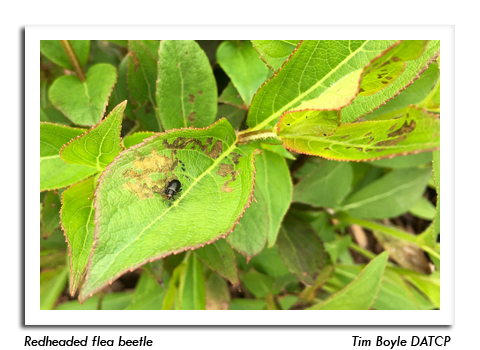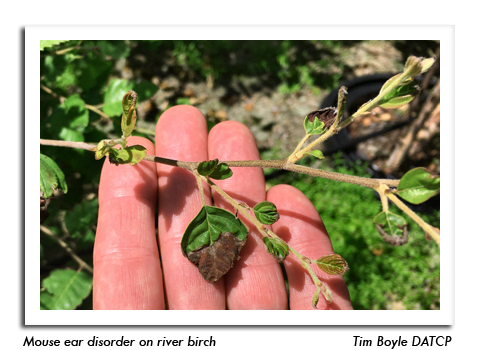
 |
|
|
Nursery & Forest
Volume 65 Number 17 Date 08/27/2020 REDHEADED FLEA BEETLE - Damage caused by redheaded flea beetles has been notably high in nurseries throughout the state this season. Once considered mainly a pest of agricultural crops, this generalist defoliator has become an increasingly serious pest on a wide assortment of nursey stock. Favored plants include dogwood, hydrangea, Itea, weigela, and various fruits and berries. Nursery managers have expressed concern about the beetles migrating from nearby crops into nursery production areas, where the threshold for damage is much lower. Because the adult flea beetles also feed on many weed species, weed control in nurseries, including container stock, is important for flea beetle management. Recent research has shown that inoculating containers with the entomopathogenic nematode Steinernema carpocapsae, when beetle larvae are active, has significantly reduced larval and adult populations. The fungi Beauveria bassiana and Metarhizium anisophliae also show promise for controlling larvae, as does azadirachtin (from neem seed), and several insecticides labeled for that use. If chemical control is justified, thorough coverage of all plant parts and growing medium is critical. Rotation of active ingredients is important to prevent resistance and limit outbreaks of other pests during the treatment cycles. SPIDER MITES - Nursery inspections continue to find heavy spider mite pressure on a variety of plants, including daylily, rose, and many other ornamentals and trees. Mite damage often intensifies as summer weather becomes hotter and drier. Initial symptoms appears as stippling or speckling on leaves and sometimes a fine webbing on the foliage. Severely infested plants eventually turn yellow and stop growing. A 10X hand lens is recommended to confirm infestation, but spider mites can often be detected by gently shaking foliage over a sheet of paper where they can be more easily seen against the white background. Light infestations can be resolved with insecticidal oil or a soap spray applied two times, 7-10 days apart. Heavy infestations may require a residual miticide. Natural enemies (ladybugs, minute pirate bugs, predatory thrips or predatory mites) are also very important for regulating mite outbreaks. Since spider mites thrive in dry, dusty conditions, rinsing tree branches and keeping bare patches of ground damp to reduce flying dust can help with control on tree farms and in orchards. MOUSE-EAR DISORDER - The river birch disorder known as "mouse-ear" disorder, "little leaf," or "squirrel ear" was observed by inspectors in a central Wisconsin nursery. According to the grower, mouse-ear has been a periodic problem in the nursery since the 1970s, particularly in container-grown river birch trees. Symptoms include stunted, wrinkled and cupped foliage, with leaves often being abnormally dark green with necrotic margins. New growth commonly has shortened internodes that give affected trees a "witches-broom" or spikey appearance. Mouse-ear commonly develops later in summer when containers become root-bound, on border rows where high root-zone temperatures reduce growth, and where sprinklers or damaged drip systems cause moisture stress. Nickel micronutrient deficiency is also thought to be a contributing factor, and foliar and drench applications of nickel sulfate are sometimes effective in reversing the disorder if applied in the early stages. Lowering soil media pH to 5.0-6.0 is also recommended. -- Tim Boyle, DATCP Nursery Inspector 

.jpg)
.jpg)

.jpg)
|
|
|